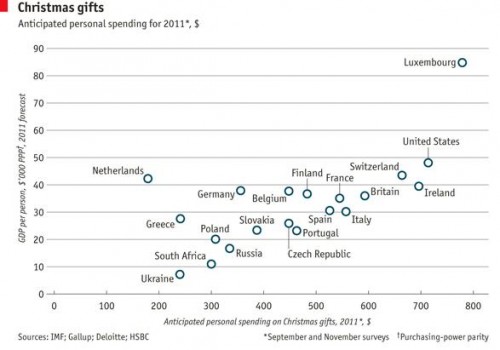As we enter the last frenzied days of Christmas shopping, Dmitriy T.M. thought it was worth looking at international comparisons in spending on the holiday. The Economist posted a graph based on Gallup polls and other data sources about how much individuals in various countries in Europe, plus the U.S. and South Africa, plan to spend on Christmas shopping this year, plotted against national GDP. Overall, Christmas spending correlates with national wealth, with the Netherlands being a noticeable outlier (spending less than we’d expect) and Luxembourg in a spending league of its own:


Comments 13
Chabas — December 13, 2011
The Netherlands spend less for Christmas because a lot of people don't celebrate it as a gift-giving occasion. I think there's about a 50/50 split these days between people giving gifts for Christmas vs St. Nickolas.
Yrro Simyarin — December 13, 2011
*Deleted - read it wrong*
vts — December 13, 2011
"Diz" a tabela anexa que, em média, cada português tenciona gastar 400€ em presentes de natal (valor médio por comparação com outros países) OU de como as médias estatísticas de pouco servem se não forem "lidas" dentro de contextos históricos e sociais e no quadro de uma hipótese.
Neste caso, coloco a hipótese de este valor poder indicar 2 aspectos: a fortíssima desigualdade nacional [exemplo: por cada português que tenciona gastar 1800€, haverá 4 portugueses que tencionam gastar 50€, o que dá uma média de 400€/pessoa]; e o forte sentimento pro-natalício.
Ciara — December 13, 2011
I'm not sure how they got almost 40k in PPP for Ireland. I think this year's GDP should be closer to 37k (we're in the middle of a recession), which would put us in line with Germany. Though we actually have twice the unemployment rate of Germany. And yet we spent twice as much as Germany? How bizarre
The site doesn't say, but were the people sampled earning exactly 39,000 a year? How were they sampled actually? If self-selecting, and if they were the type of people who read the Economist I would guess that they were actually on significantly more than that. But the Economist doesn't give its methodology so I guess we can't know.
Anonymous — December 13, 2011
I'd be very interested to see a similar graph of actual spending. I'd be willing to bet that the ratio of anticipated to actual spending might vary a bit from culture to culture.
People Can’t Tell the Difference Between a Men’s Mag and a Rapist…And More Stories « Welcome to the Doctor's Office — December 13, 2011
[...] from SocImages [...]
Christina_angelopoulos — December 14, 2011
The Dutch exchange gifts at Sinterklaas on the 5/12.
Guys Aren’t Always Thinking With Their Dick;Difficult Transition From Military to Civilian Life; And More « Welcome to the Doctor's Office — December 14, 2011
[...] INTERNATIONAL COMPARISON OF CHRISTMAS GIFT SPENDING by Gwen Sharp [...]
Daniel — December 14, 2011
Luxembourg's not so much in a *spending* league of its own as a GDP per capita league of its own; it's all by itself because of distance on the Y axis, but really not that far from the US, etc. in terms of projected spending. The graph is confusing as I think most people would expect spending on the Y axis.
Wondering — December 15, 2011
I would be interested in knowing how many people they plan to purchase for and how that impacts how much they spend. Is there a correlation between amount spent and family size? (For example)
Gift spending | Totemicmusic — March 31, 2012
[...] International Comparison of Christmas Gift Spending » Sociological …International Comparison of Christmas Gift Spending. by Gwen Sharp, Dec 13, 2011, at 03:07 pm. As we enter the last frenzied days of Christmas shopping, … [...]